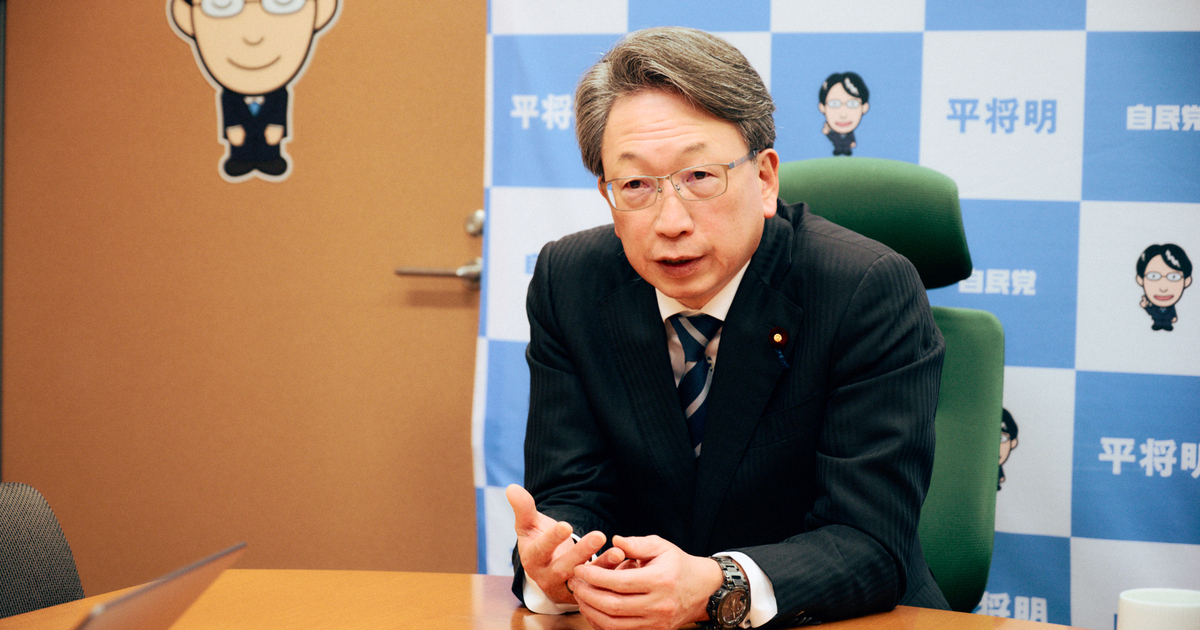
Masaaki Taira assumed office as Minister for Digital Transformation, as well as Minister in charge of Administrative Reform, Minister in charge of the National Civil Service System, Minister in charge of Cybersecurity, and Minister of State for Regulatory Reform, in October 2024. In this article, we spoke to Mr. Taira about “regional revitalization 2.0” using digital innovation and Web3.
--------------------------------------------------------------------------------------------------------------------
Ryohei Takahashi, Mercari Public Policy Councilor: First, let me congratulate you on your inauguration to office. Between the Liberal Democratic Party (LDP) presidential election and the general election, I imagine this past year must have been quite busy. But today, I’d like to talk about your medium-term vision for digital transformation in Japan next year and beyond.
First, can you explain what initiatives you’ve started recently?
Masaaki Taira: I’m strongly pushing for an e-government; to do so, I’ve taken on initiatives such as amending the Act on the Advancement of Government Administration Processes That Use Information and Communications Technology. Amid Japan’s social issue of a declining workforce, we’re running into problems in many different areas due to not having enough people. But unfortunately, the labor shortage is only going to get worse from here on out.
Each of 1,741 local governments procuring servers, developing software, and ensuring cybersecurity all on their own is not sustainable. We aim to ensure the highest standard of security by leveraging a government cloud service, as well as to use a digital marketplace to enable local governments that have procured good software to share that software with others.
Even if local governments become unable to hire the employees they need due to the labor shortage, we must maintain the quality of public services.
I also serve as the Minister in charge of the National Civil Service System, and even on a national level, we often discuss how to bring the number of national government employees up to our quota. If we think about analog solutions, the proposals inevitably involve raising salaries and benefits to attract more employees. But on a macro level, labor shortages are occurring in all fields, and individual industries just working hard to provide more appealing benefits won’t solve the real problem at hand. I think that human resources are best leveraged in the private sector; it’s unreasonable for the government to fence people in to work for them. With that in mind, analog methods aren’t the answer, which means we have to use digital solutions. Through digital transformation, I want to create a government that can automate various procedures, offer services customized to each and every individual, and provide services in a timely manner.
The Noto Peninsula earthquake occurred in January 2024. Until now, whenever there was a natural disaster, the news would often report on the long lines of people waiting to get disaster victim certificates at government offices. But this time, there were reports that these lines were significantly shorter due to people being able to apply for this certificate online, through Mynaportal or their municipal office’s website. This is the kind of visible impact that digital transformation can have.
Some people are scared of digital transformation or don’t know how to use online services, but these people still feel the benefits, because fewer people lining up in person means shorter waits.
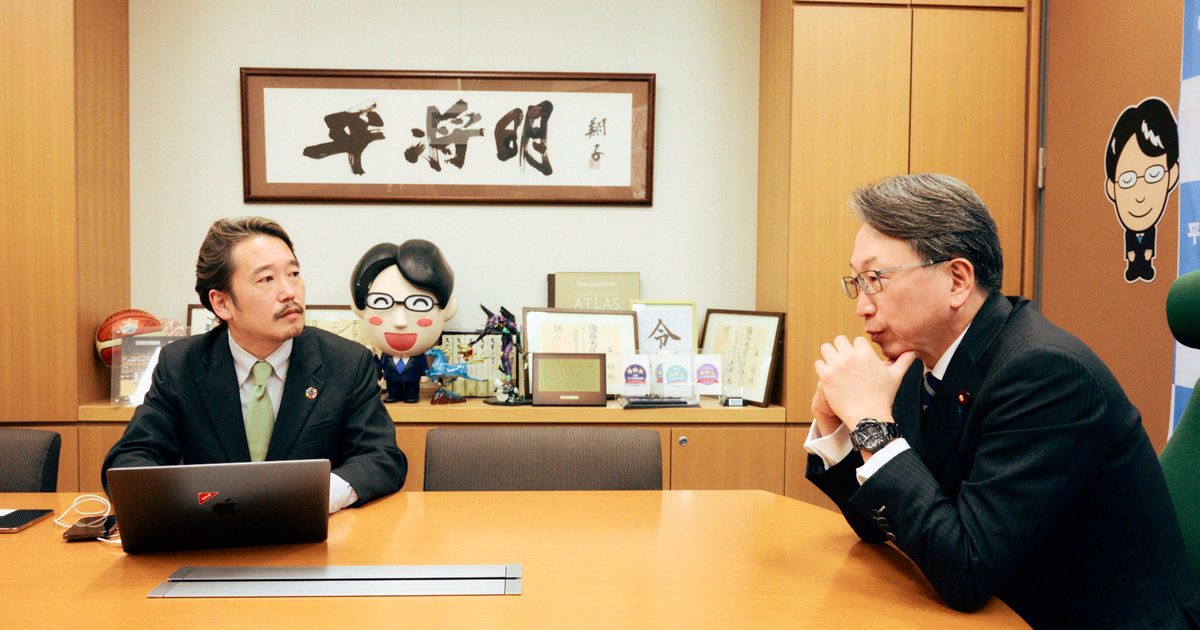
Takahashi: 2024 marked significant progress in the utilization of AI. I think AI utilization has strong potential when it comes to the government’s digital transformation. What are your thoughts?
Taira: The use of administrative support AI (government AI) is very important. In November 2024, the Digital Agency, the Tokyo Metropolitan Government, and GovTech Tokyo, which is an organization affiliated with the Tokyo Metropolitan Government, held a joint AI Ideathon/Hackathon. Top-class AI engineers in the industry got together to create prototypes of AI apps that would solve issues faced by government employees in their work. In only five hours, engineers developed a total of 38 prototypes. For example, one prototype that received much praise was an AI tool to support Digital Agency employees in creating specification documents for procurement, which to date has required expertise and a significant amount of time. Others included an administrative procedure support AI and a screening support AI. I wasn’t the only one surprised by how these proposals could improve the quality of our work—even Manabu Miyasaka, former president of Yahoo! and current Deputy Governor of the Tokyo Metropolitan Government, was impressed at how much impact AI could have.
The Digital Agency will need to confirm the safety of these tools and establish guidelines for their use, but I believe that creating digital and AI mechanisms like this will help break down vertical divisions within the government, and even the horizontal divisions between national, prefectural, and municipal governments.
For example, Japan is currently facing the large problem of crimes carried out via illegal part-time jobs run by anonymous and fluid crime groups. To address this issue, we talked with the Chairperson of the National Public Safety Commission and began a collaborative effort between the National Police Agency and the Digital Agency in which AI engineers employed by the Digital Agency are creating a prototype to use AI to identify suspicious posts on social media. An official police account then replies to the post with a caution notice to alert readers to be wary of the post. The Digital Agency estimates that this initiative could reduce the police’s social media monitoring work by 80%.
Through digital transformation in government, I hope to break down vertical and horizontal divisions and create one-to-one services.
Although I stepped away from my actual work for around a month after my inauguration to office due to the election and other reasons, I was able to implement this sort of digital government, government cloud service, and AI technology before the end of 2024.
I’d like to see business operators in the private sector utilizing AI more, too. If there are any unreasonable government regulations standing in the way of implementing or using AI, I’m also the Minister of State for Regulatory Reform, so let me know.
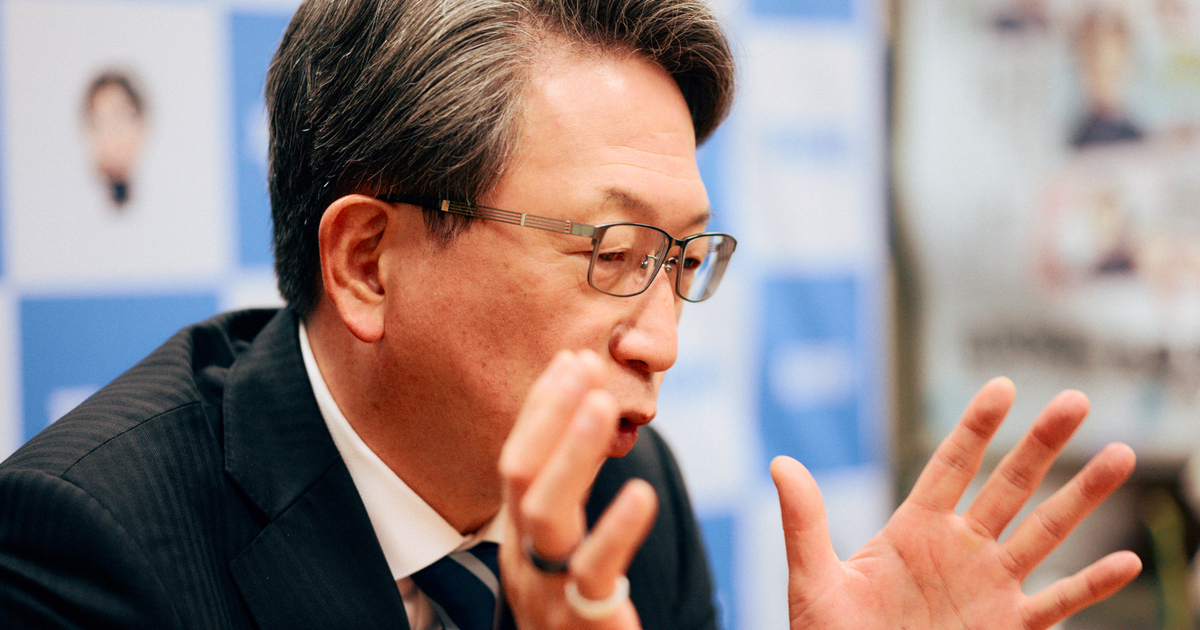
Takahashi: Recently, at an assembly of the Headquarters for Creating New Regional Economies and Living Environments attended by Prime Minister Ishiba, a basic approach to regional revitalization 2.0 was presented. You’ve talked about using Web3 for regional revitalization in the past. Can you tell us about this topic of regional revitalization 2.0?
Taira: Regional revitalization became a topic of discussion with the Abe Cabinet ten years ago, when Mr. Ishiba assumed the position of Minister in charge of Overcoming Population Decline and Vitalizing Local Economy in Japan. At the time, I was Vice-Minister, and we worked together with parliamentary official Shinjiro Koizumi and special advisor Tatsuya Ito.
When talking about how we would achieve regional revitalization, Mr. Ishiba said that it wasn’t enough for the people of a region to think of solutions among themselves. To solve the problem, we needed “outsiders, young people, and fools”—an outside perspective, young sensibility, and novel ideas.
At the time, it wasn’t realistic to gather that sort of diverse talent in regional areas with dwindling populations, but the situation is different now. In particular, there are things that we couldn’t do before, but can do now thanks to the evolution of digital technology.
One of those things is Web3 (blockchain, DAOs 1, NFTs, etc.). For example, the village of Yamakoshi in Niigata released a “Nishikigoi NFT” collection of NFTs using art of koi fish. They call these Nishikigoi NFTs “digital certificates of residence,” considering their owners to be digital residents of the village. This initiative was carried out by a DAO using the community chat app Discord to discuss ways to revitalize Yamakoshi. This is a perfect example of a form of regional revitalization that couldn’t be done ten years ago, but can be done now thanks to evolutions in technology; it’s a model case for what I think of as “regional revitalization 2.0.”
Even now, there are many cases where small towns and rural areas offer valuable experiences that can show people how fun areas outside of the city can be, but they still don’t receive the appropriate value in return. There are also many tourists visiting from overseas searching for unique things to do and see in Japan. Tourists often praise experiences in Japan as being both amazing and low-priced. How these regions can put global prices on these experiences will be a crucial question going forward. Our generation grew up with the mindset that good things should be offered at low prices, but we need to switch over to an economy of setting suitable prices for good things and actualizing added value.
Right now, our economy is about cutting costs; going forward, we need an economy focused on creating high added value.
Some people see digital art NFTs as a money game, but I think that NFTs tied to experience-based value, such as concert tickets, have enormous potential.
One example of this is a ski resort in Niseko. Niseko is a popular tourist spot for wealthy tourists. The operator of this ski resort began selling fastpasses, which enable passholders to ride ski lifts 15 minutes earlier than other guests, as NFTs. These fastpasses can be resold, and every time they are resold, a portion of the sales proceeds go to the original seller—the ski resort operator. Before NFTs, when people resold passes, art, or anything else for a higher price than what they bought it for, the only person making any money was the reseller. But NFTs enable the original seller, whether it’s a ski resort operator or an artist, to use a smart contract system that appropriately distributes the added value from reselling.
As a result, these Niseko ski resort NFTs, which were originally sold for 5,000 yen, reached a selling price of as high as 90,000 yen. This may be a particularly unique case, but I think that anywhere in Japan has the potential to sell goods that reach a selling price of several times the original value.
If you don’t know how to price something, you can turn it into an NFT and let the market decide.
A table at a Michelin-starred restaurant in Tokyo, special seating at a festival with a thousand-year history, the best spot to enjoy cherry blossoms in a famous area... Japan has a long history and many different profound forms of culture, which means it has so much value that you just can’t find elsewhere. It also has four distinct seasons, each with their own beauty, so in many regions, there’s no one “best time of year to visit”—there are unique events and sights to see in each of the four seasons. Aligning this experience-based value with global pricing will create significant value.
We’re in an age where, thanks to developments in digital technology, people can enter the market with an idea, even if they don’t have funds on hand.
From April to October 2025, Osaka will be hosting Expo 2025, which will draw even more international tourists to Japan. These tourists will be staying for a longer period of time than for events like the World Cup or the Olympics, so they will be looking for sides of Japan they haven’t seen before. Just imagine what it would look like if we could turn all the experiences Japan has to offer into NFTs, and even create a platform that lists them all in one place for tourists to easily find. It would help the economic benefits reach the people behind the scenes: the people working hard to manage attractions, the people who created the art, the people who provide the service. This is what I see as regional revitalization 2.0.
When I speak to business leaders, I compare this to a profit and loss statement.
I don’t mean to say that Japan hasn’t been trying so far, of course, but from a digital technology viewpoint, it feels to me that Japan has been focusing almost exclusively on the costs, such as introducing software and automating manufacturing to optimize administrative costs.
That’s all well and good, but I say, let’s use digital technology to transform revenue, too!
Revenue is calculated by multiplying quantity by unit price. Quantity can be solved by Web 2.0; unit price can be solved by Web3. When I talk about Web 2.0 tools, I mean things like social media, where going viral can bring in customers from all over the world, and global online shopping platforms, which open up markets in other countries. Both of these can be done without needing any funds. Unit price relates to what I mentioned earlier with regards to using NFTs to realize global prices for things with true value. We’re in an age where you can get in the game with only an idea.
Many people think of digital transformation (DX) as transforming a real-world society into a digital society, but I think that Japan’s path to success will lie in how the country can use digital technology to realize global prices for analog value around the country, such as traditional culture, experiences, and seasons, and maximize their value.
Ten years ago, we were saying, “If only we could do something about this...” Now, we can.
1. Decentralized autonomous organization (DAO): A new type of organization using blockchain in which, unlike conventional centralized authority organizations, participants work together to operate the organization
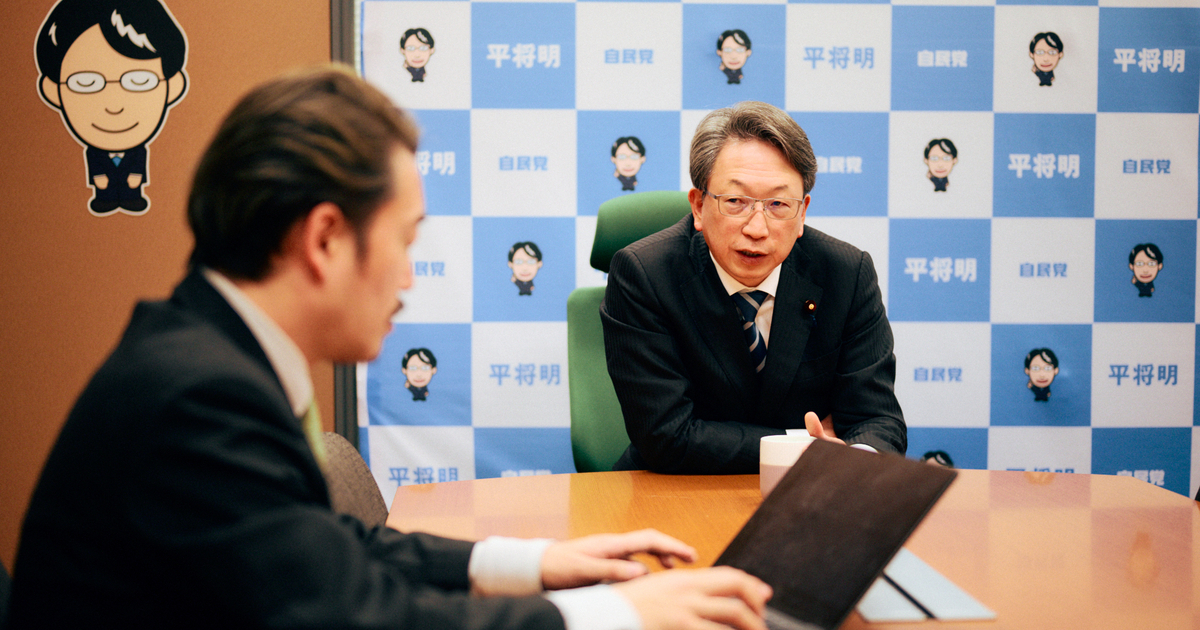
Takahashi: It sounds to me like sports and other activities have potential as content for regional revitalization, not just traditional culture and art.
Taira: My hometown is the ward of Ota in Tokyo, and I’m the president of the Tokyo Haneda Vickies 2 fan club. Ota also has the men’s B.League team Earthfriends Tokyo Z; there are both men’s and women’s professional basketball teams. The power of sports is incredible; I think that sports have significant potential for both regional revitalization and digital transformation.
One example is using Individual Number cards for fan marketing. Recently, at a J1 League soccer game between Shonan Bellmare and Hokkaido Consadole Sapporo held at a stadium in Kanagawa, there was a proof of concept where attendees could register their attendance using their Individual Number card to receive merchandise. Individual Number cards contain information about location of residence, so local fans received products from the opponent’s home prefecture of Hokkaido, and fans from Hokkaido received products from Kanagawa.3
Using NFTs can also enable true dynamic pricing.
2. The only W-League professional women’s basketball team in Tokyo
3. Source: Digital Agency’s official homepage, “Launching a Proof of Concept for Leveraging Individual Number Cards at a J.League Game Venue”
Takahashi: The world of sports in Japan is seeing a rising number of athletes active on the global stage, such as players signed to Major League Baseball teams and European soccer league teams, which in turn boosts the level of Japanese sports leagues. I think that attending sports games has the potential to become a popular choice of activity for overseas tourists.
Recently, there have been cases of J.League stadiums in areas like Nagasaki and Hiroshima being at the center of urban development planning. Do you think that urban development leveraging sports has the potential to drive regional revitalization in the future?
Taira: I think that creating an ecosystem 4 is important. For example, I love the manzai competition M-1 Grand Prix and watch it every year. I think that its appeal lies in the ecosystem it has created—new comedians can participate, and the final round is broadcast on TV.
Sports leagues like J.League and B.League offer similar ecosystems, which is why both their quality and their popularity are on the rise.
From a regional revitalization viewpoint, I think urban development centered around stadiums is a good idea, but I also want to bring this kind of content out onto the streets—for example, holding an event along roads in the center of the city. This could be a great way to leverage Japan’s national strategic special zones.
Sports have already led to increased business in areas like Hiroshima and Nagasaki for soccer and Okinawa and Chiba for basketball.
When I was growing up, willpower was everything, and people just thought of sports as a hobby, but we need to think of the business potential.
For example, the Myna Wallet service can be utilized in the same way as Japan’s public transportation cards, which can be used for payment at storefronts in addition to transportation fares. The possibilities will expand even more if we can create a stablecoin based on Japanese yen.5
If we turn stadiums cashless and offer deals like free coffee for those who show their Individual Number cards, we could encourage more use of these systems, even among older demographics. Cashless payments remove the need to manage money, reduce the danger of fraud, and decrease management costs. This could lead to revitalized shopping districts, creating fan markets, and so many more possibilities.
4. Ecosystem: An approach in which all parties coexist and collaborate with each other to create value for the whole
5. Stablecoin: A form of cryptoasset (virtual currency) designed to realize stable prices
Takahashi: So far, we’ve focused on how digital transformation can be used in public institutions, like the national and local government, and in urban development. Next, I’d like to ask: is there anything you expect from private-sector businesses like Mercari in order to move ahead with digital transformation throughout Japan?
Taira: I want the private sector to take full advantage of new technologies without fearing the risks, and to propose any ideas you have for doing so.
I think of regulatory reform and promotion of digital technology as two wheels on the same axle; innovations and regulations need to move ahead at the same pace.
Japan is slow at updating regulations to match the speed of innovation. Because of this, we lost technology like self-driving cars and drones to other countries. If there are any regulations that are standing in your way, just say the word, and I’ll do what I can to fix it. We’re also starting on initiatives to make forward-looking changes to regulations by predicting future developments.
I also hope that the government can take the approach of working to control risks with innovation, rather than trying to solve everything with regulations. I think that this approach can help Japan overcome its weaknesses and make up for the 30 years we’ve lost.
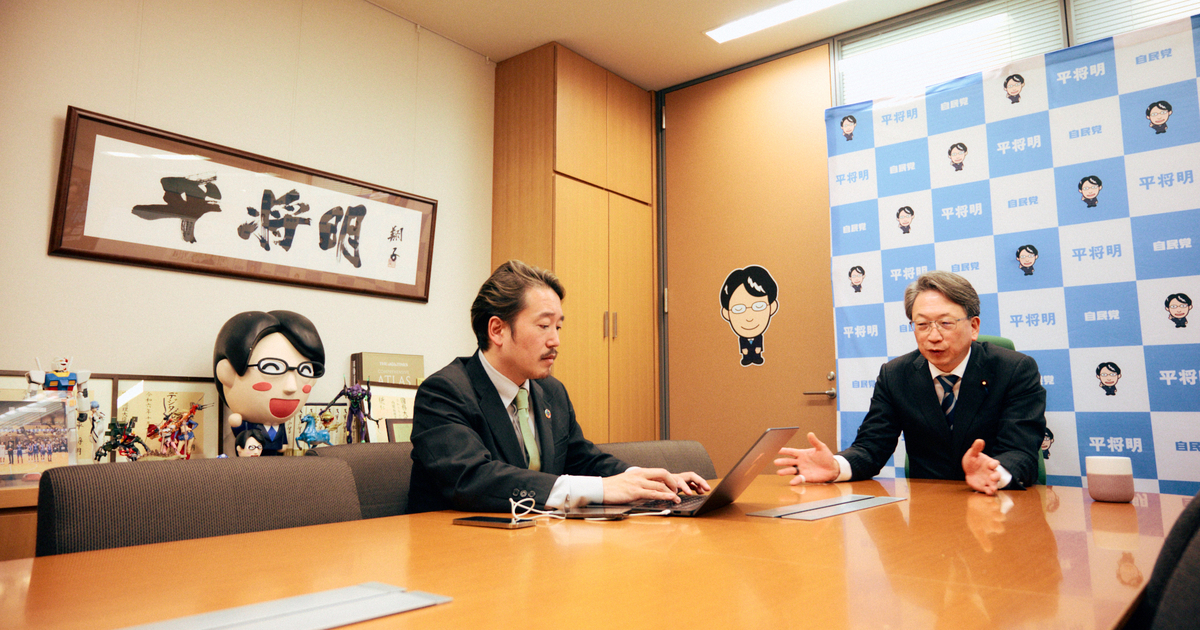
Takahashi: From previous interviews, I have the impression that the government’s policy planning and decision-making processes are gradually changing, with new mechanisms being created, and that the government’s sense of speed has increased significantly. How do you view this?
Taira: Just recently, the leading university professor in Japan praised us on our incredible speed handling policies related to generative AI. With the COVID-19 pandemic, remote work became the norm, enabling us to exchange opinions in cyberspace with people on the cutting edge of technology all across the world. Now, we can gain an accurate understanding of new technologies and issues regarding topics like blockchain and AI in only a short period of time.
On top of this, more and more young and talented Diet members are joining the LDP, and we’re holding discussions with top lawyers active on the front lines of various fields in the private sector who are working with us to create policies. Thanks to this ecosystem, I was able to assemble a project team that created a comprehensive policy package regarding Web3 and generative AI and presented it as a white paper in only two months, without needing to borrow the help of government bureaucrats.
Looking at the rest of the world, the EU takes a long time to come to a consensus and reach implementation. They recently reached a decision on an AI bill, but the actual implementation won’t be until two years from now. But AI is a field that is constantly changing—who knows what it will look like in two years.
In Japan, we will focus on adapting quickly to changes, unlike the regulation-focused approach taken by the EU.
The US’s policies change significantly depending on who is elected president, but Japan hasn’t gone back on its policy even when the Prime Minister has changed.
Japan is trying to move quickly despite having a civil law system; in order to do so, we need the foresight to see what’s to come in the future. We’re working to keep regulations and rules to a minimum so we can adapt quickly.
We actually published the white paper in English for the rest of the world. Having a clear governmental stance on generative AI has a strong effect on encouraging investments. OpenAI and Google chose Japan as the location for their first AI research location in Asia; GAFAM and Oracle invested 2.9 trillion yen in an AI data center.
I think it’s crucial to keep this trend going.
Hiroshi Amano, Mercari Public Policy Councilor: OpenAI o3, the successor to OpenAI o1, is said to have an IQ of 157. How do you think this kind of AI should be leveraged?
Taira: When talking about how Japan can leverage cutting-edge AI technology, the human-in-the-loop approach (a method in which an AI and humans collaborate on tasks) is important. By having humans actively participate in training AI and decision-making processes, we can increase the reliability and maximize the performance of AI. Fundamentally, we control the risks of giant AI models that rapidly evolve with hard law. I think it will be important for the newly established AI Safety Institute6 to work together with Japan, the US, the UK, and Australia in this area.
Through 2024, the main areas of leveraging generative AI have been text, language, images, and videos, but I believe that using AI in robots will be a major topic in 2025 and beyond. With that in mind, Japan has included this area in our revised budget, and we hope that companies will make use of these available funds.
6. AI Safety Institute (AISI): An organization that works to discuss and promote methods and criteria for evaluating the safety of AI in order to realize AI technologies that are safe, secure, and reliable
Takahashi: Before we end the interview, I’d like to ask one more question. This interview will be published on Mercari’s public policy blog Merpoli in early 2025. Do you think that 2025 will mark serious progress toward the future that you’ve talked about today?
Taira: I think that 2025 will be a year full of chaos. But chaos is a great chance for those lagging behind to catch up. I hope that you and everyone out there reading this will not shy away from the chaos, and instead think about how to take advantage of this opportunity.
--------------------------------------------------------------------------------------------------------------------
Masaaki Taira
Masaaki Taira is a member of Japan’s House of Representatives, as well as Minister for Digital Transformation, Minister in charge of Digital Administrative and Fiscal Reform, Minister in charge of Administrative Reform, Minister in charge of the National Civil Service System, Minister in charge of Cybersecurity, and Minister of State for Regulatory Reform. After graduating from Waseda University’s School of Law, he took over his family’s business. In 2005, he was elected to the House of Representatives in the 44th general election, his first time running. Since then, he has held positions such as Parliamentary Vice-Minister of Economy, Trade and Industry and Parliamentary Vice-Minister of Cabinet Office (second Abe cabinet), Deputy Secretary-General of the Liberal Democratic Party, and State Minister of Cabinet Office (fourth Abe cabinet [second reshuffle]).
Interviewers
Ryohei Takahashi
Ryohei is Public Policy Councilor in Mercari’s Management Strategy Office and editor-in-chief of Merpoli. He previously worked as a specially appointed associate professor at Chuo University. He also currently serves as a Chairperson of the Supporting Association for Student Council Activity Japan. After holding positions such as a department head for Matsudo City, DX promotion advisor for the prefecture of Kanagawa, advisor to the city of Chiba, visiting researcher at Meiji University, researcher at the International Institute for Research on Public Policy at the Graduate Institute for Entrepreneurial Studies, researcher at the Tokyo Foundation, researcher at Public Policy Planning & Consulting Co., Ichikawa City council member, and chairperson of the Meeting of Young Council Members of Japan, he joined Mercari in June 2018. Ryohei has been selected as one of the “Top 100 People Rebuilding Japan” by Aera magazine and has authored books such as What Is an Intergenerational Gap? (PHP Shinsho), A Textbook for 20-Year-Olds (Nikkei Premium Shinsho), and An 18-Year-Old Out to Change Politics! (GendaiJinbun-Sha).
Hiroshi Amano
Hiroshi is a councilor to the Management Strategy Office’s Policy Planning Division at Mercari. At the beginning of his career, in 2008, he joined the Ministry of Internal Affairs and Communications (MIC). During his time at MIC, he worked on various projects including the expansion of the Japanese digital terrestrial TV broadcasting system in Latin America, reconstruction efforts in the areas devastated by the Great East Japan Earthquake, and promotion of more widespread usage of 5G. Between 2016 and 2019, he was seconded to the Wakayama Prefectural Government Office, where he proposed and implemented a “workation” system—the first for a local government in Japan. In 2019, he played a major role in establishing Workation Alliance Japan. After leaving MIC, he joined Mercari in September 2021. He also serves as advisor to the Japan Workcation Association, advisor to Wakayama Prefecture’s New Wakayama Prefecture Comprehensive Plan, and team leader of the Wakayama Future Creation Platform.
